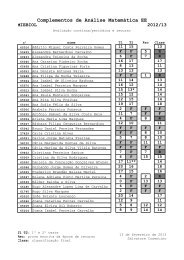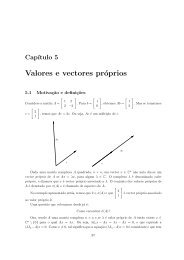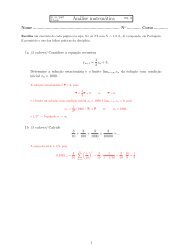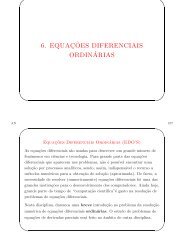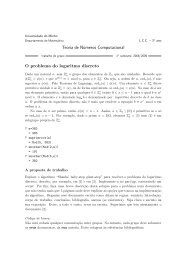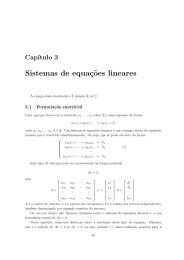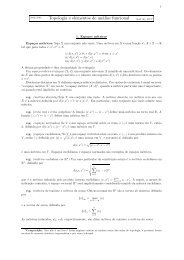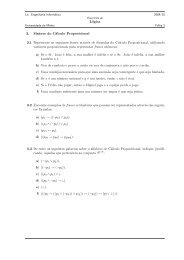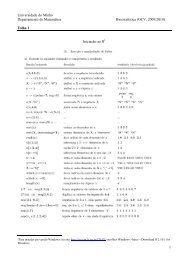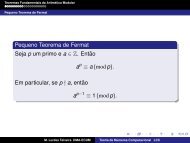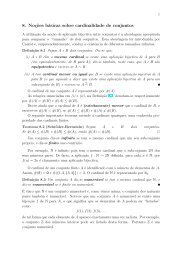My title - Departamento de Matemática da Universidade do Minho
My title - Departamento de Matemática da Universidade do Minho
My title - Departamento de Matemática da Universidade do Minho
Create successful ePaper yourself
Turn your PDF publications into a flip-book with our unique Google optimized e-Paper software.
10 STATISTICAL DESCRIPTION OF ORBITS 72<br />
Gauss map.<br />
of the form<br />
Any irrational real number x ∈ ]0, 1] has a unique continued fraction representation<br />
x = [0; a 1 , a 2 , a 3 , . . . ] =<br />
a 1 +<br />
1<br />
a 2 +<br />
1<br />
1<br />
a 3 + 1<br />
. ..<br />
where the a n are nonnegative integers. The equality sign and the “infinite fraction” above mean<br />
that the sequence of finite continued fractions<br />
1<br />
r n = [0; a 1 , a 2 , . . . , a n ] =<br />
1<br />
a 1 +<br />
1<br />
a 2 +<br />
. .. 1 +<br />
a n<br />
which are called “convergents”, <strong>do</strong> converge to x as n → ∞. The sequence of rationals r n (any<br />
such r n provi<strong>de</strong> the best rational approximation for x with <strong>de</strong>nominator less or equal than that<br />
of r n , as you may have been teached in a course on number theory) is inductively constructed as<br />
follows. First, observe that if a 1 = [1/x] and x 1 = 1/x − a 1 we may write<br />
1<br />
x =<br />
a 1 + x 1<br />
with x 1 ∈ [0, 1]. Then, since x 1 ≠ 0, for otherwise x would be rational, we may <strong>de</strong>fine a 2 = [1/x 1 ]<br />
and x 2 = 1/x 1 − a 2 to get<br />
1<br />
x =<br />
1<br />
a 1 +<br />
a 2 + x 2<br />
Inductively, we see that<br />
1<br />
x =<br />
1<br />
a 1 +<br />
1<br />
a 2 +<br />
... + 1<br />
a n+xn<br />
where x n = 1/x n−1 − a n and a n = [1/x n−1 ]. This amounts to say that the sequence (x n ) is the<br />
trajectory of x un<strong>de</strong>r the Gauss map g : ]0, 1] → ]0, 1], <strong>de</strong>fined as<br />
x ↦→ 1/x − [1/x]<br />
Observe that g is not <strong>de</strong>fined at the origin, hence to iterate g we need to avoid all the preimages<br />
of 0, which are the rationals. This is not a problem if we want to study the statistical properties<br />
of g with respect to Lebesgue measure, since rationals form a subset of zero measure. The Gauss<br />
map admits an absolutely continuous invariant measure µ = ρdx, <strong>de</strong>fined as<br />
µ (A) = 1<br />
log 2 ·<br />
∫<br />
A<br />
1<br />
1 + x dx<br />
for any Borel subset A ⊂ ]0, 1]. The <strong>de</strong>nominator log 2 is there to normalize the measure, so we<br />
just have to check the invariance criterium for the <strong>de</strong>nsity ρ (x) = 1/ (1 + x). Since any x ′ ∈ ]0, 1]<br />
has one preimage x k = 1/ (x ′ + k) in each interval ]1/ (k + 1) , 1/k], we compute<br />
∑<br />
x∈g −1 {x ′ }<br />
ρ (x)<br />
|<strong>de</strong>t g ′ (x)|<br />
x 2 k<br />
= ∑ 1 + x k<br />
k≥1<br />
= ∑ ( )<br />
1<br />
x ′ + k − 1<br />
x ′ + k + 1<br />
k≥1<br />
=<br />
1<br />
1 + x ′ = ρ (x′ )



